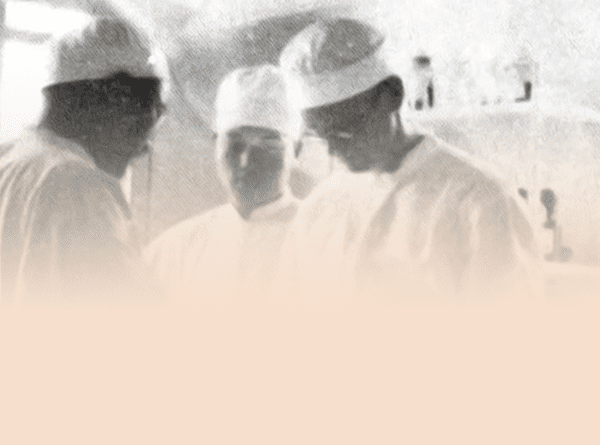Is the Law to Blame?
By George C. Chapman
Christian Medical Society Journal, Winter 1977, Volume VIII, Number 1.
As a lawyer presenting his case to physicians, I feel a bit defensive. The attitude of many people in our society is reflected in a recent bumper sticker -"Support your local lawyer, send your son to medical school:' Yet I do not believe that lawyers bear the greatest blame for what is taking place. Instead key changes in our local court system and substantive law have produced the flood of lawsuits being filed against physicians, hospitals and nurses.
The first change affected the statute of limitations. Formerly, in foreign body cases, where a needle or a sponge had been left inside a patient, the statute of limitations restricted the case to two years unless the patient could prove fraudulent concealment by the physician. Now the courts have overruled that theory of law and in its place have established the discovery concept. A plaintiffs cause of action begins at the time of discovery of the foreign body. In other cases where a patient does not know about adverse complications which certain drugs produce, he can still bring his lawsuit as long as 10 or 15 years later. Actually the courts feel they are acting from a moral standpoint. The plaintiffs should not lose their cause of action merely because they are unaware of a problem. At any rate, the discovery concept has triggered a great deal of litigation.
Second, the Supreme Court in abolishing the defense based on charitable immunity for hospitals has brought on more suits. A decade ago litigation filed against private hospitals was ineffective since negligence by a nurse or a hospital employee was covered by the charitable immunity doctrine. Once more the courts believe that they have acted on a moral issue. A patient injured by a nurse's negligence, for example, should not be denied recovery simply because the institution in which she works has charitable immunity.
Captain of the Ship
Third, the courts have established the doctrine of the captain of the ship. Simply stated, this theory maintains that a physician is responsible for the negligence of those who work under his supervision.
Still another contribution to the malpractice crisis is the reversal of the attitude in appellate courts with regard to the summary judgment practice. Using this method, a defense lawyer could get the court to rule as a matter of law that a suit had no merit. As a result, the case would be dismissed before it was brought to trial. Ten years ago the summary judgment was commonly used to gain dismissal of medical malpractice cases. Now the courts are more sympathetic to the plaintiff. No longer are summary judgments easily granted. As a result, more lawsuits are filed, more cases are tried and more expense must be covered by additional premium costs.
The overruling of what is known as the community concept offers another explanation for increased malpractice litigation. In the past, a physician in one city could not testify against a physician in another city unless he could affirm that he knew the standards of care in the second city. With the abolition of this concept, physicians in different states or other areas of a state are freer to testify about negligence or causation, the prerequisites for a jury trial.
erequisites for a jury trial. In addition, younger doctors are more willing to testify against other physicians. Lawyers who have been defending physicians for many years often express surprise at this attitude. Perhaps this springs from high ideals or because young doctors have never faced litigation themselves. Or perhaps they have not realized how easily lawsuits can be brought against even the most skilled doctors who practice according to the highest standards.
Increased litigation has also developed as a result of the doctrine of informed consent. According to this theory a patient facing surgery must be informed of certain consequences and risks. If he is not adequately informed of possible hazards, then consent is not considered given.
A side effect which appears as a result of informed consent is that some surgeons go beyond the law and discuss with their patients every conceivable adverse complication. In taking this paranoid attitude, a new standard of care may be established which is far too idealistic. Other surgeons might be considered negligent if they were not able to achieve such ideals. Carried to extremes this overcaution could eliminate elective surgery.
Suitable Solutions
From a legal standpoint, solutions to the problem of malpractice appear difficult. Yet there are a few suggestions which might ease the current tensions. For example, to counteract the contingency fee arrangement, a screening panel might arbitrate a case. The decision of the panel could avoid costly lawsuits.
Deductible insurance might also lower premiums. The physician would assume the first $5,000-$10,000 of risk. Such a proposal, though, would place pressures on the beginning practitioner who has little additional money after paying for his medical education and bearing the cost of setting up his practice.
What is needed most I believe is an education for the American public. They must become aware that the current trends could take us to a national disaster. Many competent, qualified physicians retire in their late 50s or early 60s, feeling that the costs are too great. Immense insurance premiums and the possibilities of losing what they have saved during their medical careers drive them to early retirement. That appears to me to be a moral matter that affects the entire country. When men at the height of their careers decide to drop out of medicine, then it is the public who suffers and the society sustains an irreparable loss. The malpractice crisis must not be considered a medical problem or even a legal dilemma. It is a national problem with which concerned men and women must cope.
In January of 1977 the Texas Supreme Court disapproved the Captain of the Ship doctrine and held that for a physician to be responsible for the negligent acts of a nurse, the jury must find the nurse was the doctor's "borrowed servant."
George C. Chapman is an attorney practicing in Dallas, Texas (1977).














